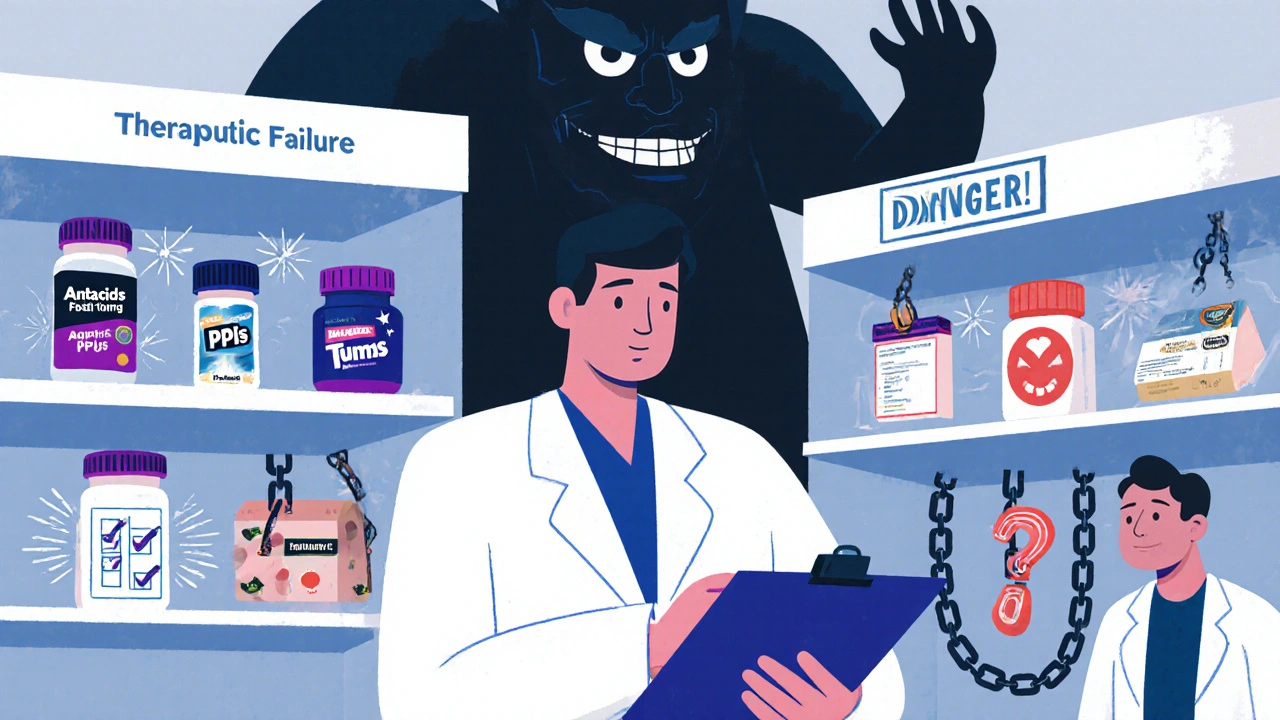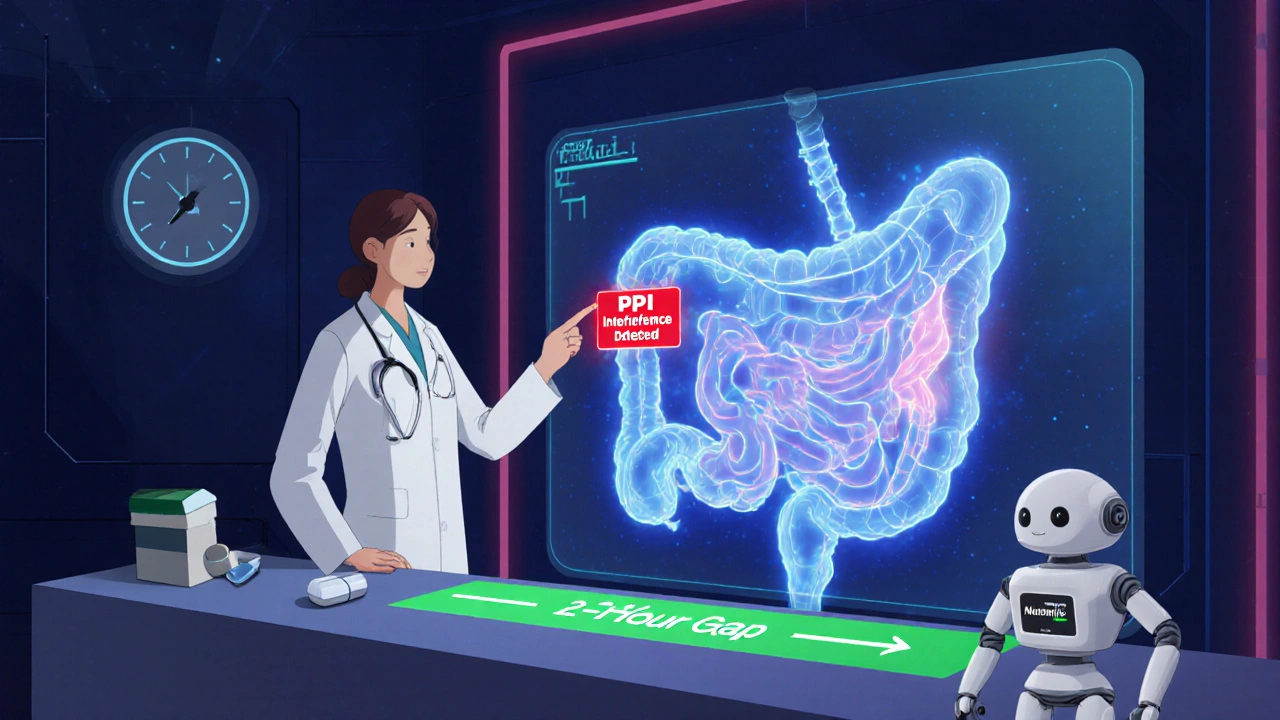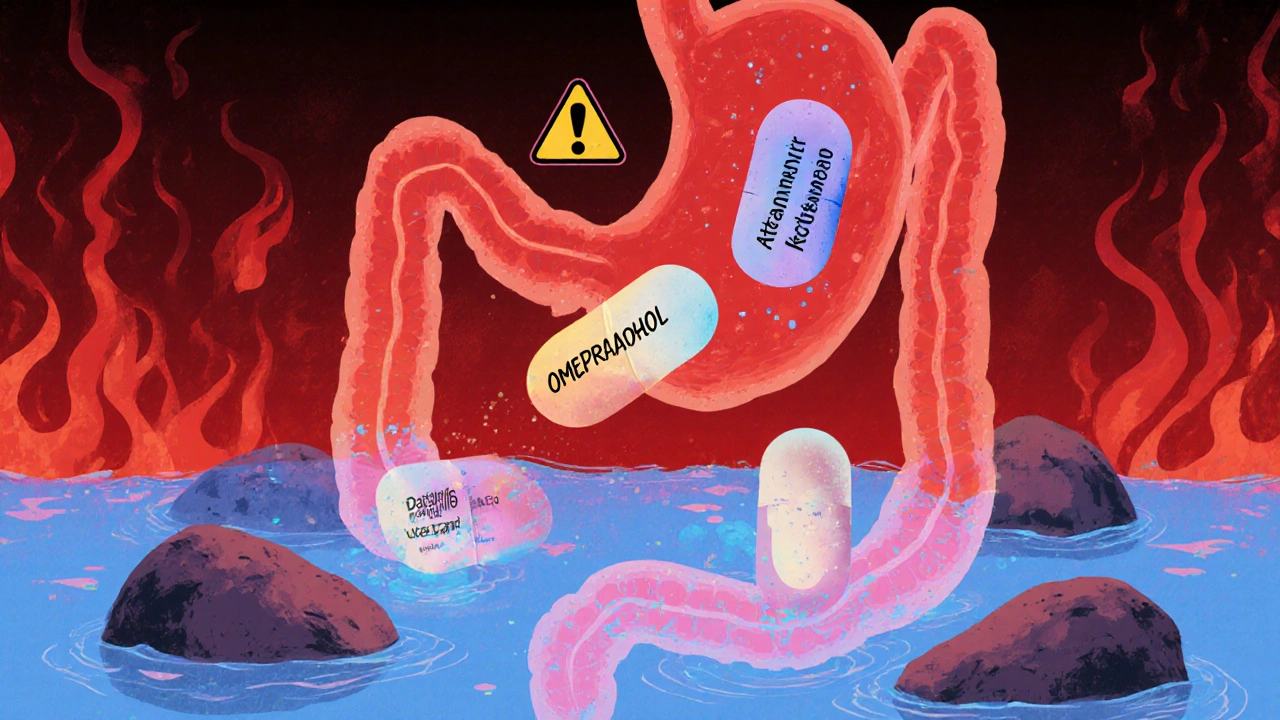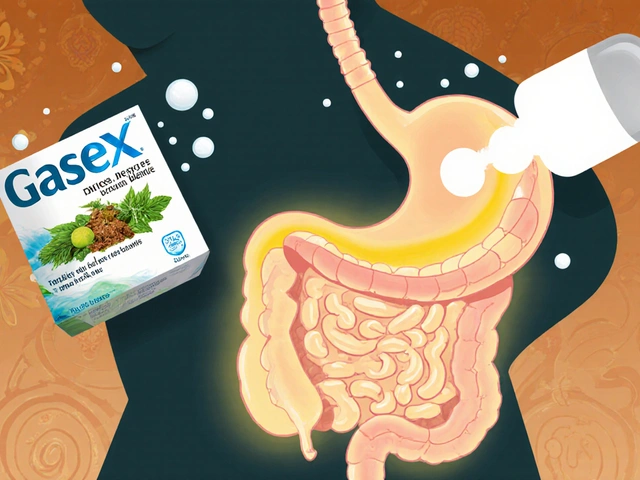Acid Medication Interaction Checker
Check for Medication Interactions
Interaction Analysis
interaction with acid reducers:
Recommendations
Most people take acid-reducing meds like omeprazole or famotidine for heartburn or stomach ulcers. They work great. But what most don’t know is that these common drugs can quietly sabotage other medications they’re taking-sometimes with serious consequences. This isn’t theory. It’s happening in real time, every day, to thousands of people who never saw it coming.
How Acid-Reducing Drugs Change Your Gut Environment
Proton pump inhibitors (PPIs) like omeprazole, esomeprazole, and lansoprazole, and H2 blockers like ranitidine and famotidine, work by turning down stomach acid. Normally, your stomach pH drops to 1.0-3.5 when you’re fasting-strong enough to break down food and kill bacteria. These drugs raise that pH to 4.0-6.0, sometimes for 14-18 hours a day. That sounds harmless, but your stomach isn’t just a digestion chamber. It’s the first checkpoint for how well your body absorbs many medicines.
Most drugs don’t get absorbed in the stomach. About 90% of absorption happens in the small intestine. But here’s the catch: many drugs need to dissolve before they get there. And dissolution? It depends heavily on pH.
The Science Behind the Interference
Drugs are either weak acids or weak bases. The ones most affected by acid reducers are weak bases-medications that need an acidic environment to dissolve properly. Think of them like salt: salt dissolves easily in water, but not in oil. Weak bases dissolve well in acid, not in alkaline conditions.
When you take a PPI, your stomach stops being acidic. That means weak base drugs stay in their non-ionized form, which doesn’t dissolve well. They don’t break apart. They don’t get absorbed. They just sit there, pass through your gut, and get flushed out. The result? Your blood levels of that drug drop-sometimes by 70% or more.
Take atazanavir, an HIV medication. When taken with a PPI, its absorption drops by 95%. That’s not a small tweak-it’s treatment failure. Viral load spikes. Resistance builds. One Reddit user wrote: “My viral load went from undetectable to 12,000 copies/mL after starting Prilosec.” That’s not anecdotal. It’s documented in FDA reports.
Dasatinib, used for chronic myeloid leukemia, sees a 60% drop in absorption with PPIs. Ketoconazole, an antifungal, becomes practically useless. Even blood pressure meds like nilotinib can lose effectiveness. The FDA says about 25-50% of the top 200 prescribed drugs in the U.S. are weak bases at risk.
PPIs vs. H2 Blockers: Not All Acid Reducers Are Equal
Not all acid-reducing drugs are the same. PPIs are the big offenders. They suppress acid for longer-up to 18 hours-and raise pH higher. H2 blockers like famotidine only work for 8-12 hours and don’t raise pH as much. So while both can interfere, PPIs are far more dangerous.
A 2024 study in JAMA Network Open found PPIs reduce absorption of pH-sensitive drugs by 40-80%. H2 blockers? Only 20-40%. That’s a huge difference. If you’re on a high-risk drug like atazanavir or dasatinib, switching from a PPI to an H2 blocker might help-but only if you space them out. Even then, it’s not foolproof.

Who’s at Risk? The High-Risk Drugs
Some drugs are more vulnerable than others. The FDA has flagged 12 high-risk medications where interactions with acid reducers are well-documented and clinically dangerous:
- Atazanavir (HIV treatment): Avoid PPIs entirely. Even a single dose can cause viral rebound.
- Dasatinib (leukemia): Absorption drops 60%. Dose adjustments or staggered timing may help.
- Ketoconazole (antifungal): Becomes ineffective. No workaround.
- Eliglustat (Gaucher disease): Requires strict avoidance.
- Myfortic (mycophenolate mofetil): Reduced absorption can lead to organ rejection in transplant patients.
- Levothyroxine: Absorption drops up to 25%, leading to untreated hypothyroidism.
- Iron supplements: Need acid to dissolve. PPIs can make them useless.
- Clopidogrel: Some studies show reduced activation, though this is debated.
Even drugs like calcium, magnesium, and vitamin B12 can be affected long-term. Chronic PPI use is linked to deficiencies because your body can’t absorb them without acid.
Real-World Consequences
This isn’t just about lab numbers. It’s about people getting sicker because their meds don’t work.
A 2023 study of over 12,500 patients found those taking dasatinib with a PPI had a 37% higher chance of treatment failure. That means more relapses, more hospitalizations, more chemo cycles. In the FDA’s adverse event database, over 1,200 reports of therapeutic failure between 2020 and 2023 were tied to these interactions. Atazanavir alone accounted for over 300 cases.
One Drugs.com user wrote: “My doctor didn’t tell me Nexium would interfere with my blood pressure meds-my readings were consistently 20 points higher until we figured it out.” That’s not rare. It’s predictable.

What Can You Do? Practical Solutions
Don’t stop your acid reducer without talking to your doctor. But do ask these questions:
- Is my acid reducer necessary? The American College of Gastroenterology says 30-50% of long-term PPI users don’t need them. Deprescribing is often safer than continuing.
- Is my other medication on the high-risk list? Check the label. If it says “avoid with proton pump inhibitors,” that’s not a suggestion-it’s a warning.
- Can we space them out? For some drugs, taking the weak base 2 hours before the PPI can help. It’s not perfect, but it can cut the interaction by 30-40%.
- Can we switch to an antacid? Tums or Maalox? They work fast and don’t last long. Take them 2-4 hours apart from your other meds. But don’t use them daily-they’re not meant for that.
- Ask your pharmacist. A 2023 study showed pharmacist-led reviews cut inappropriate ARA co-prescribing by 62% in Medicare patients. Pharmacists see these interactions every day.
The Bigger Picture
Over 15 million Americans take PPIs long-term. Many do it without a clear diagnosis. In Australia, where I live, the numbers are similar. The global market for these drugs is $18.7 billion. But the cost? Over $1.2 billion a year in wasted healthcare spending from failed treatments, ER visits, and repeat hospitalizations.
Pharmaceutical companies are responding. New drugs in development are being designed to avoid pH-dependent absorption. AI tools are being built to predict interactions before they happen. Electronic health records now flag dangerous combinations-Epic Systems says 78% of doctors follow those alerts.
But technology alone won’t fix this. Patients need to be informed. Doctors need to ask. Pharmacists need to speak up.
What’s Next?
The FDA’s 2023 guidance now requires drugmakers to test new medications across a pH range of 1.0-7.5. That’s good. But it’s still reactive. The real win will be prevention.
Doctors are starting to screen for PPI use before prescribing high-risk drugs. Some clinics now run gastric pH tests to see how much acid suppression a patient actually has. That’s personalized medicine in action.
By 2027, the American Gastroenterological Association expects a 25% drop in inappropriate PPI use. That could prevent 5,000-7,000 cases of therapeutic failure each year. That’s lives saved.
If you’re on a chronic acid reducer and another medication, don’t assume it’s safe. Ask. Double-check. Get it in writing. Your life might depend on it.
Can acid-reducing medications make my other drugs stop working?
Yes. Proton pump inhibitors (PPIs) and H2 blockers raise stomach pH, which can prevent weak base drugs from dissolving properly. This reduces how much of the drug enters your bloodstream. Drugs like atazanavir, dasatinib, and ketoconazole can lose up to 95% of their effectiveness when taken with PPIs, leading to treatment failure.
Are all acid-reducing drugs equally risky?
No. PPIs like omeprazole and esomeprazole are far more dangerous than H2 blockers like famotidine. PPIs suppress acid for 14-18 hours a day and raise pH higher, making them more likely to interfere with drug absorption. H2 blockers work for only 8-12 hours and cause smaller pH changes, so their risk is lower-but still present.
What should I do if I’m on both an acid reducer and another medication?
Don’t stop either without talking to your doctor. First, ask if you really need the acid reducer-many people take them longer than necessary. Then, check if your other drug is on the high-risk list (e.g., atazanavir, dasatinib). If so, ask about spacing doses (take the other drug 2 hours before the acid reducer) or switching to an antacid like Tums, used only as needed.
Can I take antacids like Tums with my other medications?
Yes, but timing matters. Antacids work quickly and only last a few hours. Take them at least 2-4 hours before or after your other medication. This avoids the pH spike that interferes with absorption. Don’t use antacids daily-they’re not meant for long-term use and can cause side effects like diarrhea or constipation.
Why don’t doctors always warn patients about this?
Many doctors aren’t aware of the full scope of these interactions, especially with older medications. Also, patients often don’t mention they’re taking over-the-counter acid reducers. A 2023 study showed pharmacist-led reviews reduced inappropriate co-prescribing by 62%. If you’re on multiple medications, always tell your pharmacist about everything you take-including antacids and herbal supplements.
Are there any new treatments that avoid this problem?
Yes. Pharmaceutical companies are developing new drugs that don’t rely on stomach pH for absorption. Around 37% of new drug candidates in development now use pH-independent delivery systems. Some are using enteric coatings that only dissolve in the intestine, bypassing the stomach entirely. AI tools are also being trained to predict these interactions before a drug hits the market.





November 22, 2025 AT 15:59 PM
Just had a patient on dasatinib start omeprazole for ‘heartburn’-viral load spiked within weeks. No one asked about OTC meds. This is why pharmacists need to be part of the care team, not just pill dispensers. I’ve started flagging every PPI prescription with high-risk drugs in my system. It’s saved at least three people from relapse this year.
November 23, 2025 AT 15:39 PM
Wow. I’ve been on omeprazole for 5 years for ‘acid reflux’-never thought it could mess with my blood pressure med. My doc never mentioned this. I’m scheduling a med review tomorrow. Thanks for the wake-up call.
November 24, 2025 AT 10:44 AM
They don’t want you to know this. Big Pharma makes billions off PPIs AND the drugs that fail because of them. They bury the data. The FDA? Complicit. The real cure? Apple cider vinegar and fasting. But you won’t hear that from your ‘doctor’-he’s on their payroll. Check the 2022 whistleblower documents on PubMed.
November 25, 2025 AT 06:18 AM
Oh my god… I take omeprazole and levothyroxine… I’ve been tired for years… I thought it was stress… I just checked my med list-levothyroxine is on the high-risk list… I’m going to call my pharmacist right now… I can’t believe no one told me…
November 26, 2025 AT 05:57 AM
One must question the epistemological foundations of this piece. The notion that pH alters drug absorption is not novel-it’s pharmacokinetics 101. Yet the author presents it as revelation, as if the medical community has been asleep at the wheel. The real scandal? The overmedication of the American populace. PPIs are prescribed like candy. But the solution isn’t more warnings-it’s less prescribing. And less gullibility.
November 27, 2025 AT 20:00 PM
This is terrifying. I’m a transplant nurse. I’ve seen patients reject organs because their Myfortic didn’t work-and no one connected it to their daily Prilosec. We need mandatory pharmacist alerts at the point of prescription. Not optional. Not ‘maybe.’ Mandatory. And we need to stop blaming patients for not knowing. The system failed them.
November 29, 2025 AT 14:18 PM
Let’s analyze the data: 1,200 FDA reports over 3 years. That’s 0.004% of PPI users. The risk is statistically negligible. Meanwhile, the mortality rate from untreated GERD is 12x higher than from suboptimal drug absorption. This article is fearmongering dressed as science. Also, ‘weak base drugs’? That’s not even accurate terminology. It’s pKa-dependent solubility. Please consult a pharmacologist before writing.
November 30, 2025 AT 18:21 PM
Bro this is wild 😱 I had no idea my Tums were messing with my antifungal! I’ve been taking them for years. I’m switching to famotidine tonight and spacing it out. Also-pharmacists are heroes 🙌 Thanks for the real talk!
December 1, 2025 AT 02:03 AM
Global health implications are profound. In low-resource settings, where therapeutic drug monitoring is unavailable, this interaction becomes a silent killer. The WHO should issue a global alert. This isn’t just an American problem. It’s a public health blind spot.
December 1, 2025 AT 20:15 PM
LMAO so now we’re blaming Big Pharma for people being dumb? If you can’t read the label on your meds, maybe don’t take them. Also, ‘weak base drugs’? Sounds like something from a high school chem class. I take Nexium and my chemo works fine. Maybe your doc sucks.
December 2, 2025 AT 00:02 AM
Of course they don’t tell you. The entire pharmaceutical-industrial complex thrives on chronic dependency. PPIs are the gateway drug to a lifetime of prescriptions. And now they’re weaponizing ‘drug interactions’ to scare you into staying on the treadmill. Who benefits? The same people who sold you the statins, the antihypertensives, the antidepressants. Wake up.
December 2, 2025 AT 14:07 PM
Bro I’ve been taking PPIs since 2018 and my HIV meds work fine. You’re just FUD-ing. Also, I take Tums with my vitamins and I’m glowing 🌟 #NoMorePharmaBrainwashing #VitaminDIsTheRealCure
December 3, 2025 AT 19:40 PM
So we’re now treating the stomach like a chemistry lab? Who decided that a human body is just a series of pH-dependent reactions? We’re not test tubes. We’re messy, evolved, paradoxical beings. Maybe the real solution isn’t spacing pills-but asking why we’re all so damn acidic in the first place. Meditation? Sunlight? Less sugar? Nah. Let’s just tweak the pH and call it medicine.